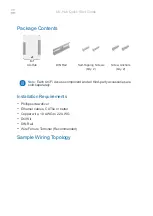
Disable/Enable Operation
Operating Instructions
MS-5UD and MS-10UD Series Manual —
P/N 52626:B1 6/30/2009
115
4.10 Disable/Enable Operation
Input zones which are disabled do not cause an alarm or any zone activation. Disabled NACs are
held in the off state. All disabled zones/NACs are treated as if they were in trouble, with the
exception being the status label that will be displayed is
DISABL
.
4.11 Waterflow Circuits Operation
If an alarm exists from a zone that is a waterflow non-silenceable type, the Alarm Silence key will
not function.
4.12 Detector Functions
Maintenance Alert
i
3
smoke detectors will be polled for maintenance and freeze conditions on initial entry into Normal
mode. Thereafter, each device will be polled every hour for freeze and every four hours for
maintenance conditions All alarm and system trouble conditions are annunciated on the control
panel’s LCD.
Note: To ensure that the system is functioning properly, the FACP will perform a freeze check five
minutes after the panel is reset, followed by a maintenance check. If there is no freeze or
maintenance condition, the panel will continue to monitor for freeze conditions every hour and
maintenance conditions every four hours.
System Alarm Verification
The control panel may be programmed to perform alarm verification to help eliminate the nuisance
of false alarms. Alarm verification applies to smoke detectors only.
4.13 Time Functions: Real-Time Clock
The FACP includes a crystal-based clock that provides time of day, date and day of week. Time is
displayed as 12 or 24 hour time with month/day/year and is stored in RAM. Daylight savings time
change-over is programmable and automatic. If both AC and battery are lost, the time must be
reprogrammed.
4.14 Coded Operation
The NAC circuits resident on the control panel main circuit board can be programmed for coded
operation. The available pulse rates which can be programmed for coded operation are as follows:
•
Continuous:
Steady output with no pulsing
•
March Time:
Pulses at 120 ppm (pulses per minute)
•
Temporal Code:
Pulses at ½ second On, ½ second Off, ½ second On, ½
second Off, ½ second On, 1½ second Off
•
California Code:
10 seconds On, 5 seconds Off
•
Two-Stage
Pulses at 20 ppm (pulses per minute) for 3 or 5 minutes
and then changes to Temporal
















































